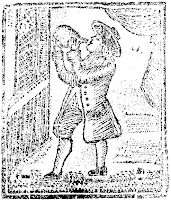How to Upset Your Commander-in-Chief
 From Gen. George Washington’s general orders to the entire Continental Army around Boston, issued 27 July 1775:
From Gen. George Washington’s general orders to the entire Continental Army around Boston, issued 27 July 1775:
For the future when any Deserters come to any of the out Guards, they are with the least delay to be sent by a Corporals Guard, to the next Guard in the Lines, who is immediately to escort them in the same manner to the Major General commanding that division of the Army, who as soon as he has examined them will forthwith send them under a proper Escort from his guard to the head quarters [now Longfellow National Historic Site in Cambridge]:I’d love to have been privy to the new commander-in-chief’s attempt to interrogate those British army deserters while they were under the influence of New England rum.
Some Deserters being made drunk, who came last night from the Enemy, before they reached Head Quarters; It will be considered as a Breach of orders in any person, who gives Rum to Deserters, before they are examined by the General.

1 comment:
When Washington arrived in Cambridge in early July 1775, the first place he lived was the Wadsworth House, alongside Gen. Charles Lee.
After a couple of weeks, both generals moved out, Washington to the house on Brattle Street that John Vassall and his family had left behind, and Lee to the house in Medford that Isaac Royall and his family had left behind. Washington remained in the Vassall House until early April 1776. He thus made that house his headquarters longer than any other building except for where he lived in Newburgh, New York, at the end of the war.
Later that house was bought and expanded by Andrew Craigie, who had supplied medicines to the Continental Army. He left his wife in debt, so she took in boarders from the Harvard faculty. While living there, history professor Jared Sparks told languages professor H. W. Longfellow about how Washington had used the house. When Longfellow married for a second time, his bride’s father, a textile magnate, bought the mansion and had it fixed up for them.
The Longfellows lived in that house for the rest of their lives, and two more generations, usually calling it “the Craigie house” but being very proud of its Washington connection. After the family gave it to the federal government, it became Longfellow National Historic Site. Some of us of a Revolutionary bent would like to see it renamed Longfellow and Washington’s Headquarters National Historic Site to reflect all the historical events that took place there.
I don’t know anything about Washington living in a house beside Cambridge Common. A tradition developed in the mid-1800s that Washington had reviewed all his troops under an elm on that common when he arrived, but there’s little evidence to support that. He attended services in Christ Church, which is also next to the Common. So there are probably plaques and markers about Washington dotting the area.
Post a Comment